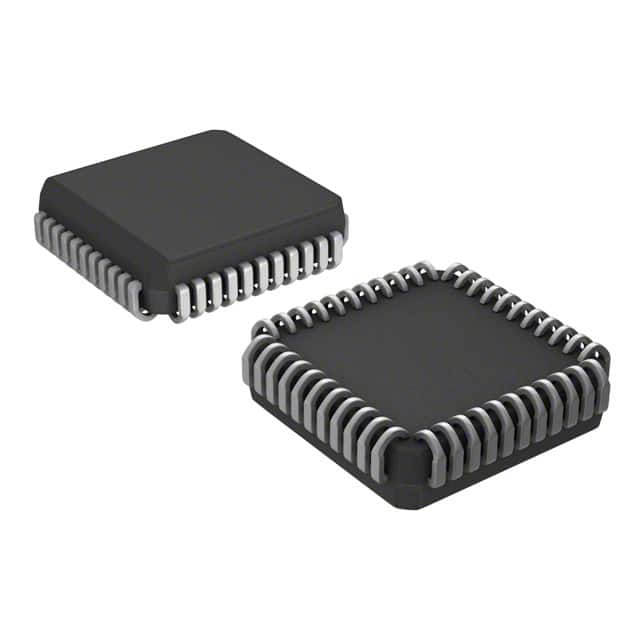Подробную информацию о продукте см. в характеристиках.

EPM3032ALC44-4
Product Overview
Category
The EPM3032ALC44-4 belongs to the category of programmable logic devices (PLDs).
Use
This device is primarily used for digital circuit design and implementation. It offers a flexible and customizable solution for various applications.
Characteristics
- Programmable: The EPM3032ALC44-4 can be programmed to perform specific functions based on user requirements.
- High Integration: It integrates multiple logic gates, flip-flops, and other components into a single chip.
- Versatile: This PLD can be used in a wide range of applications due to its programmability.
- Compact Package: The device is packaged in a 44-pin LCC (Leadless Chip Carrier) package.
Package and Quantity
The EPM3032ALC44-4 is available in a 44-pin LCC package. Each package contains one unit of the device.
Specifications
- Device Type: Programmable Logic Device (PLD)
- Package Type: 44-pin LCC
- Operating Voltage: 3.3V
- Maximum Operating Frequency: 50 MHz
- Number of Logic Elements: 32
- Number of Input/Output Pins: 36
- Programmable Logic Blocks: 16
- Maximum User I/Os: 32
- On-Chip Memory: 1,000 bits
- JTAG Boundary Scan Support: Yes
Pin Configuration
The detailed pin configuration of the EPM3032ALC44-4 is as follows:
| Pin Number | Pin Name | Description | |------------|----------|-------------| | 1 | VCC | Power Supply Voltage | | 2 | GND | Ground | | 3 | IO0 | Input/Output Pin 0 | | 4 | IO1 | Input/Output Pin 1 | | ... | ... | ... | | 43 | IO34 | Input/Output Pin 34 | | 44 | IO35 | Input/Output Pin 35 |
Functional Features
- Programmability: The EPM3032ALC44-4 can be programmed using hardware description languages (HDL) or design software to implement desired logic functions.
- High-Speed Operation: With a maximum operating frequency of 50 MHz, this PLD can handle complex digital circuits efficiently.
- Flexible I/O Configuration: The device offers 32 user I/O pins that can be configured as inputs or outputs based on the application requirements.
- JTAG Boundary Scan Support: The inclusion of JTAG boundary scan support allows for easier testing and debugging of the device.
Advantages and Disadvantages
Advantages
- Flexibility: The programmable nature of the EPM3032ALC44-4 enables customization and adaptability to different applications.
- Integration: The device integrates multiple logic elements into a single chip, reducing the need for external components.
- Cost-Effective: By eliminating the need for custom-designed circuits, this PLD reduces development costs.
Disadvantages
- Limited Complexity: The EPM3032ALC44-4 has a limited number of logic elements, which may restrict its use in highly complex designs.
- Programming Expertise Required: Utilizing the full potential of this PLD requires knowledge of HDL programming or design software.
Working Principles
The EPM3032ALC44-4 operates based on the principles of programmable logic. It consists of configurable logic blocks (CLBs), interconnect resources, and input/output blocks. The CLBs contain lookup tables (LUTs) that can be programmed to implement specific logic functions. The interconnect resources allow for the routing of signals between different CLBs and I/O blocks. By programming the LUTs and configuring the interconnect, users can define the desired logic behavior of the device.
Detailed Application Field Plans
The EPM3032ALC44-4 finds applications in various fields, including:
- Industrial Automation: It can be used to implement control systems for manufacturing processes, robotics, and machinery.
- Communication Systems: The PLD can be utilized in network routers, switches, and telecommunications equipment.
- Automotive Electronics: It can be employed in automotive control units, driver assistance systems, and infotainment systems.
- Consumer Electronics: The device can be integrated into smart home devices, gaming consoles, and multimedia systems.
- Medical Equipment: It finds application in medical imaging devices, patient monitoring systems, and laboratory equipment.
Alternative Models
For those seeking alternative options, the following models are worth considering:
- EPM3064ATC100-10: A similar PLD with higher logic capacity and more I/O pins.
- EPM240T100C5N: A smaller PLD with lower logic
Перечислите 10 распространенных вопросов и ответов, связанных с применением EPM3032ALC44-4 в технических решениях.
Sure! Here are 10 common questions and answers related to the application of EPM3032ALC44-4 in technical solutions:
Q: What is EPM3032ALC44-4? A: EPM3032ALC44-4 is a specific model of programmable logic device (PLD) manufactured by Altera.
Q: What is the purpose of EPM3032ALC44-4 in technical solutions? A: EPM3032ALC44-4 is used for implementing digital logic functions, such as combinational and sequential circuits, in various electronic systems.
Q: What are some typical applications of EPM3032ALC44-4? A: EPM3032ALC44-4 can be found in applications like industrial control systems, telecommunications equipment, automotive electronics, and consumer electronics.
Q: How does EPM3032ALC44-4 differ from other PLDs? A: EPM3032ALC44-4 offers 32 macrocells, 32 inputs, and 32 outputs, making it suitable for small to medium-sized digital designs.
Q: Can EPM3032ALC44-4 be reprogrammed after it has been configured? A: No, EPM3032ALC44-4 is a one-time programmable (OTP) device, meaning its configuration cannot be changed once programmed.
Q: What programming languages or tools are commonly used with EPM3032ALC44-4? A: EPM3032ALC44-4 can be programmed using hardware description languages (HDLs) like VHDL or Verilog, along with design software provided by Altera.
Q: Is EPM3032ALC44-4 suitable for high-speed applications? A: While EPM3032ALC44-4 can operate at relatively high clock frequencies, it may not be the best choice for extremely demanding high-speed applications.
Q: Can EPM3032ALC44-4 interface with other components or devices in a system? A: Yes, EPM3032ALC44-4 can interface with other digital components through its input and output pins, allowing it to communicate with other parts of a system.
Q: Are there any limitations or considerations when using EPM3032ALC44-4? A: Some considerations include limited macrocell count, limited I/O pins, and the fact that it is a one-time programmable device.
Q: Where can I find more information about EPM3032ALC44-4 and its application in technical solutions? A: You can refer to the datasheet and application notes provided by Altera (now Intel) for detailed information on EPM3032ALC44-4 and its various applications.

